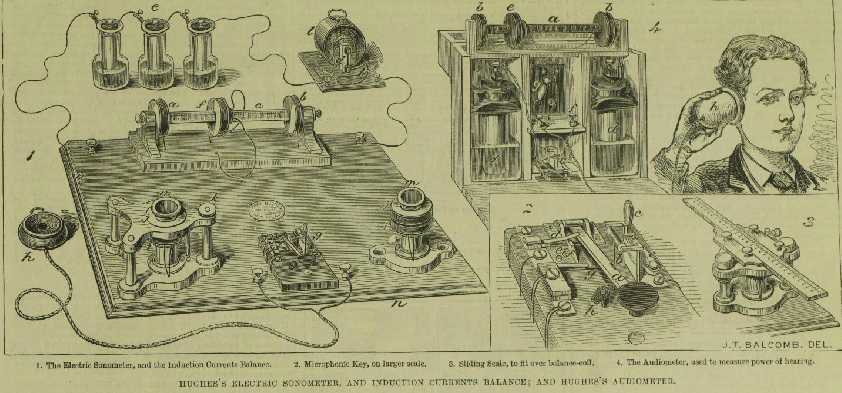Roots of Audiology – the Audiometer
By H Dominic W Stiles, on 15 May 2015
Modern audiology was only really possible with late 19th century advances in technology and the understanding of electromagnetism that allowed for the measurement of hearing ability. This allowed the invention of the audiometer, then the development of transistors to replace valves enabled the amplification of sound in a convenient portable device, which became the ‘modern’ hearing aid in the 1940s.
The audiologist has roots in both the medical and the technical –
- there were the otolaryngologists, doctors who treated and investigated hearing,
- then there were those who sold instruments like ear trumpets and their ilk, the dispensers,
- and there were the scientists who developed the theories of acoustics, and the instruments that were used to measure hearing.
One of the latter was David Edward Hughes who was a pioneer of the microphone (which we covered in a previous blog). Hughes, a great experimenter, developed his ‘audiometer’ at around the same time (1879), and it was first mentioned in his article in the Proceedings of the Royal Society, On an Induction-Currents Balance, and Experimental Researches Made Therewith.
During the course of these experiments with this instrument I noticed my own hearing powers varied very much with state of health, weather, &c., that different individuals had wide differences of hearing, and that in nearly all cases one ear was more sensitive than the other; thus whilst my degree of hearing was 10, another might be 60 in one ear and 15 in another.*
*To this portion of my instrument when used as a measurer of our hearing powers, we have given the name of audiometer.
( Hughes 1879 p.58)
 The Illustrated London News (see picture with the sonometer to the left and the audiometer numbered 4) described the device –
The Illustrated London News (see picture with the sonometer to the left and the audiometer numbered 4) described the device –
The audiometer, an adaptation of the sonometer, being an instrument for exactly measuring our power of hearing and chronicling the progress of recovery from deafness. It was first applied by Dr. Richardson to some very remarkable investigations relative to our hearing powers. a is the scale measured into 200 millimetres. bb are the two primary fixed coils, both exactly similar to those in the sonometer as to length and size of wire, although what should be the thinner coil is here padded out, so that they look both alike as to depth.
The wires from these coils are connected with the microphone, c, and Leelanche’s battery cells, dd; e, secondary and moving coil, connected through the binding screws, ff, to the telephone, h. The switch, g is a brass arm pivoted on an ebony plate, on which are also fixed two brass studs. The free end of arm placed over either of these gives either the force of one or, when desired, two cells, the stronger current being used only for very deaf patients. (Illustrated London News , 1879)
Benjamin Ward Richardson, a great friend of Hughes, experimented with this instrument, and coined the name.
“In this preliminary report I have omitted many subjects of interest, but I hope I have related enough to show that the world of science in general, and the world of medicine in particular,is under a deep debt of gratitude to Professor Hughes for his simple and beautiful instrument, which I have christened the audimeter, or less correctly but more euphoniously, the audiometer.” (Richardson, 1879)
Richardson was a close friend of John Snow of cholera fame, and a remarkable man in his own right, being a physician, sanitarian, anaesthetist and historian of medicine.
In his 1979 article on Hughes and his audiometer, Stephens says Hughes “does not appear to have been interested in the application of his audiometer”. Hughes was awarded a Royal Society Gold Medal in 1885, and his funeral in Highgate was attended by the U.S. ambassador as well as representatives of the governments of Serbia, France and Greece (Stephens, p.3). Richardson was also diverted by his many other interests and did not pursue research with the audiometer.
T.Hawksley, who manufactured and sold hearing devices, went into production with the “Hughes’ Sonometer” in 1883, and it seems it was still available as late as 1912 (Stephens p.4).
Audiometers do not seem to have taken off however, and Stephens says there are few references to them in the otolaryngological textbooks of the period. It was only with the increased use of valve audiometers in the 1930s that audiology as a separate discipline began to find its own place.
Hughes, D.E., On an Induction-Currents Balance, and Experimental Researches Made Therewith, Proceedings of the Royal Society of London, 1879 Volume 29, pp. 56-65
Hughes’s Electric Sonometer and Balance, and Audiometer.Illustrated London News (London, England), Saturday, November 15, 1879; pg. 463; Issue 2109
Richardson, B.W., Some Researches with Professor Hughes’ New Instrument for the Measurement of Hearing; the Audiometer, Proceedings of the Royal Society of London, 1879 Volume 29, pp. 65-70
Stephens, S.D.G., David Edward Hughes and his audiometer. Journal of Laryngology and Otology, 1979, Volume 93 pp.1-6
 Close
Close

